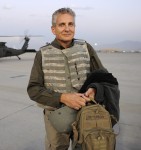Between The Lines: An Operation Thriller USO Tour Recap by Andrew Peterson with Clive Cussler, Sandra Brown, Kathy Reichs, and Mark Bowden
“My favorite memory is of the tour of the hospital at Bagram. The dedication of the men and women who work there was readily apparent. They’re optimistic, hopeful, and determined to save lives. Their spirit was inspiring. The ceiling of Warrior’s Way, the emergency bay where the wounded arrive, is draped in an American flag that once flew over Ground Zero. Seeing that put a huge lump in my throat.” – Sandra Brown
I think Sandra’s words perfectly reflect the essence of Operation Thriller II. All of us who flew halfway around the world to thank and acknowledge our service members found it rewarding beyond words and we came home with more than we gave. This is a difficult feature to write because it’s hard to quantify the experience. It’s my sincere hope that as you read this feature, the thoughts and perspectives of Sandra, Clive, Mark, and Kathy will deepen your appreciation of our troops serving in harm’s way.
USO is an acronym for United Service Organizations. It’s mission and purpose is to lift the spirits of America’s troops and their families. And yet our spirits were constantly being lifted. Everywhere we went, our service members thanked us. Perhaps that’s what it’s all about. A USO tour embodies the essence of goodwill—an exchange of kindness and support. We saw it in their eyes, when they said thank you to us, it made them feel better. The reverse was also clearly true. Each of us felt a deep sense of fulfillment.
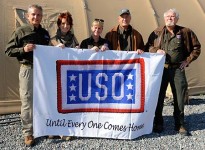 So what is the USO and how was it formed? In 1941 it became more and more apparent that the United States was going to enter World war II. As a result, many organizations and associations began mobilizing to address and ease the needs of service members and their families. If a household’s breadwinner went off to war, how was his or her family supposed to support itself? A mother with six children couldn’t just drop everything and get a job. Organizations like the Salvation Army, the Young Men’s Christian Association, the Young Women’s Christian Association, the National Catholic Community Services, National Travelers Aid Association and the National Jewish Welfare Board stepped up to fill the monetary and spiritual needs of Americans affected by the war.
So what is the USO and how was it formed? In 1941 it became more and more apparent that the United States was going to enter World war II. As a result, many organizations and associations began mobilizing to address and ease the needs of service members and their families. If a household’s breadwinner went off to war, how was his or her family supposed to support itself? A mother with six children couldn’t just drop everything and get a job. Organizations like the Salvation Army, the Young Men’s Christian Association, the Young Women’s Christian Association, the National Catholic Community Services, National Travelers Aid Association and the National Jewish Welfare Board stepped up to fill the monetary and spiritual needs of Americans affected by the war.
It didn’t take Franklin D. Roosevelt’s administration long to recognize the need to create synergy and coordination among these agencies. The United Service Organizations was formed with that objective. It’s a nongovernmental entity based on the voluntary effort thousands of individuals who share a common goal: to remind service members and their families that America cares, supports, and appreciates the sacrifices of those who defend her. Hands down, Bob Hope is the most famous of all the USO’s entertainers who selflessly donated his time and money to one of America’s most worthy organizations.
Over time, the USO has adapted and evolved. It’s continuously developing new programs and facilities designed to meet the ever-changing needs of our troops and their families, while holding fast to the original mission of spiritual support. One of the USO’s goals is to deliver a piece of America far from home.
How did ITW become involved with the USO? Around two years ago, ITW member Andy Harp—a fellow author who served in the Marines—had the insight and energy to approach the USO and suggest it produce a tour with thriller authors. After hundreds of hours of hard work and dedication, Andy’s dream came true. For the first time in its 70 year history, the USO sent authors overseas on tour. In November of 2010, ITW authors James Rollins, David Morrell, Andy Harp, Doug Preston, and Steve Berry went to Iraq and Kuwait. Operation Thriller I was such a huge success, it spawned Operation Thriller II and a third tour is planned for 2012 with Kathleen Antrim chairing the event.
I’m pleased to offer insights from my fellow authors. As I said, it’s difficult to adequately express what Operation Thriller II meant to us and the service members we visited. The focus of this feature will be more on the intangible aspects of our tour. It would literally take 20,000 words to describe everything we saw and did. To get a good feel for scene and setting, the USO website has a dozen photos posted of the tour.
Clive Cussler is 80 years old and although I haven’t been able to verify it, I believe he set or tied a record attending a USO tour into an active war zone. I asked Clive where he found the energy to keep going when all of us were exhausted beyond all hope and sanity. He said he drew strength from our troops.
 “All of our service men and women were extremely dedicated to their efforts in behalf of our country. They appeared quite earnest in their respective duties and I never heard complaints as was common when I was in the Air Force during the nineteen-fifties. Meeting these men and women who are bound to their duty was truly inspirational.”
“All of our service men and women were extremely dedicated to their efforts in behalf of our country. They appeared quite earnest in their respective duties and I never heard complaints as was common when I was in the Air Force during the nineteen-fifties. Meeting these men and women who are bound to their duty was truly inspirational.”
Kathy Reichs has similar feelings about the sacrifices being made on our behalf.
“I recall speaking to many service members who spoke of the hardship of separation from their families. Mothers who had left toddlers and teens. Fathers who had yet to see their newborn babies. One Marine who spoke of the importance of regular telephone contact. Yet, he said, it was often difficult to find common topics for conversations. He thanked me for the books and the show, saying Temperance Brennan and her exploits gave him and his family safe ground for sharing.”
Toward the end of our tour, Mark Bowden and I were in a recreational facility called Pete’s Place inside the Manas Transit Center in Kyrgyzstan. We sat down with a couple of Army service members and I introduced Mark as the author of BLACK HAWK DOWN. One of the soldiers nearly jumped out his chair with excitement. He went on to say that Mark’s book influenced him so strongly, he enlisted to serve. Mark recalls the conversation.
“When I hear a comment like the one from the soldier in Manas, my first thought is: Oh my God, I’m not sure I want that responsibility! But it is, of course, deeply flattering. To hear that a reader was so moved and inspired by something you wrote that it changed his life is the highest sort of praise. I am grateful to have such serious readers. Ultimately, of course, it wasn’t me who so inspired that young man, it was the brave soldiers who fought in the Battle of Mogadishu.”
I admire Mark’s genuine modesty, but he spent five years researching and writing the story and his book made its way into that soldier’s hands. And it’s a good thing it did. The soldier told us that joining the Army changed his life and saved him from a dark and hopeless future. He talked about his life prior to the Army, how he’d lacked purpose and drive and had been on verge of joining a street gang. The Army taught him about discipline, teamwork, and respect.
This brings up an important point. Our service members are consummate professionals. We never saw an unkempt uniform or piece of personal equipment or gear out of place. They’re also ultra safe with the weapons they carry. With very few exceptions, every soldier is required to keep his weapon him at all times.
Our introduction to Operation Enduring Freedom occurred when we landed in Bishkek, Kyrgyzstan. At this point we’d all been traveling for over 20 hours. Sandra was at 23 hour mark and because I started on the west coast and had to drive 3 hours to the San Francisco Airport, I’d logged over 30 hours. I’d lost track of time at this point. All I knew was that it was dark outside. At the civilian terminal, we met our Air Force liaison and guide, a nice lady who’s a master sergeant.
Much to Clive’s dismay, his suitcase didn’t arrive with the rest of our bags at the luggage carousel. Despite assurances from the Air Force they’d track it down, he was really concerned, but Clive’s a trooper. He never once griped or complained. I couldn’t blame him for being apprehensive, I know how I would’ve felt if my bag turned up MIA—not the greatest way to begin an overseas USO Tour.
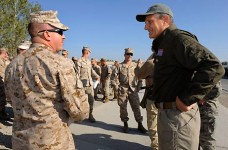 It took around an hour for Jeremy Wilcox (our USO tour producer) to buy our visas and clear customs. We boarded a white Air Force van for the drive into the transit center. The Transit Center at Manas is surrounded by Hesco barriers. Hesco barriers are made of individual heavy mesh cages with canvass liners Each unit is approximately four feet square and five feet high. They’re filled with dirt and rocks and stacked 3 units high like a stepped pyramid. They’re used as explosive and vehicle barriers on the perimeter fences. The tops are lined with antipersonnel razor wire. There are miles of Hesco barriers surrounding the facility.
It took around an hour for Jeremy Wilcox (our USO tour producer) to buy our visas and clear customs. We boarded a white Air Force van for the drive into the transit center. The Transit Center at Manas is surrounded by Hesco barriers. Hesco barriers are made of individual heavy mesh cages with canvass liners Each unit is approximately four feet square and five feet high. They’re filled with dirt and rocks and stacked 3 units high like a stepped pyramid. They’re used as explosive and vehicle barriers on the perimeter fences. The tops are lined with antipersonnel razor wire. There are miles of Hesco barriers surrounding the facility.
The Transit Center at Manas is home to the 376th Expeditionary Air Support Wing. It’s the lead refueling wing and premier mobility hub for operations over Afghanistan. The wing’s around-the-clock missions include aerial refueling, airlift and airdrop, and aeromedical evacuation support when needed.
We arrived at our barracks building around 0430 and set our alarms for 0800. We parted company with Sandra and Kathy who were required to stay in one of the female barracks units. Our housing is made of prefab linear buildings with no windows at all. The buildings are approximately 30 feet wide, 150 feet long, and 20 feet high. We ended up on the second floor in an 8×10 room with two bunk beds. I shared a room with Mark. Jeremy roomed with our official USO photographer, Mike Theiler and Clive ended up with a room to himself. The showers and latrine were down the hall and pretty basic. Two hours of sleep later, I turned off my iPhone alarm so it wouldn’t wake Mark. A check-in with Jeremy yielded some good news. Clive’s bag had been located and I delivered it to his room at 0700.
Later that morning, we visited the transit center’s headquarters and met the deputy commanding officer and her supporting staff. We exchanged gifts before heading out to meet and interact with the troops.
Perhaps our most memorable introduction to the military lifestyle occurred later that night. At 1700 hours, we relocated into the personnel terminal and were issued our individual body armor and helmets (IBA) for the duration of our stay. Collectively, they weigh around 40 pounds. We staged in a lockdown area with several hundred Marines inside the terminal and waited for our flight downrange.
A few hours later, we boarded a bus along with a platoon of Marines. Out on the flight line, we met our ride, a C-130J Hercules—a four engine turboprop.
I asked Kathy to offer some thoughts on our flight downrange.
 “The letter C pretty much covers it:
“The letter C pretty much covers it:
Crowded. We sat shoulder to shoulder, knee to knee with our fellow USO authors and an engineering company of Marines. Everyone was bulked out in their IBA’s. My flak jacket totaled roughly a third of my body weight. Our helmets and backpacks were jammed under the seat or held on our laps.
Cold. Being a rookie at riding transport planes, upon boarding, I took any random unoccupied jump seat. By blind luck I chose the middle row. While I went rocking every time the guy behind me re-positioned his spine against the netting, those seated along the plane’s outer walls endured frigid air flow up their backs the whole trip.
Cacophonous. These planes were not built with passenger comfort in mind. The noise of the engines made ear plugs mandatory. Which made conversation impossible without a whole lot of yelling.
Curtain. Comfort facilities consisted of a commode on a small platform, six steps up, in the middle of the plane, surrounded by a curtain arrangement that had to be held in place by a buddy, in my case, Sandra! Getting there meant crawling over the laps of dozens of Marines. For me, toilette was out of the question.
Caliginous. (Really. It means dark. Check a Thesaurus. OK. I’m pushing the alliteration way too far). Throughout the flight the lights were kept very dim. Upon arrival at our destination, the plane went totally black, veered quickly toward Earth, and landed on the airstrip. The maneuver is designed to keep the plane out of the range of small-arms fire for as long as possible. It kept my stomach well up in my throat.
But the flight had one thing in common with many I’ve taken on American domestic carries. We were told the trip would last just under three hours. Five hours after going wheels-up and after an intermediate stop at Camp Dwyer offload the Marines and their equipment, we finally touched down at Bagram Air Field, Afghanistan.
Two of my fondest memories of the tour involve tributes to the show. On entering one facility, an episode of Bones was playing on a huge projection screen. (It was the only program besides football and an occasional news broadcast that I saw my entire time in Afghanistan!) One day, on the take-off roll in a C-130, the Bones theme song was played for our benefit over the loud speaker system. Whoo-hoo!”
The musical tribute definitely lightened the atmosphere. During landings and take-offs, the flight crewmembers (loadmasters) were glued to small windows with night vision goggles looking for the twinkle of incoming AK fire Had they seen it, they would’ve immediately reported it to the pilot who would’ve executed a series of evasive maneuvers. Fortunately, no one fired at us. Just to be on the safe side, our California Air National Guard pilot made some gentle jinking and swerving moves on final approach before she lined up on the runway. The only source of light came from outside the aircraft, so the touchdown startled us. One second we were flying, the next, we were rolling down the runway.
We met our Bagram Air Field liaisons around 0100 hours, and half an hour later we settled into our accommodations for the night, a B-hut (short for barracks hut.) We ended up approximately 500 yards from the flight line and heard the near constant roar of jets coming and going at all hours. The F-15E Strike Eagles using afterburners were exceptionally loud, they literally vibrated the plywood structure surrounding us.
Our epic Herky Bird flight was only the first of many transport flights. Later that same day we climbed into a Black Hawk helicopter. For Mark, it was especially significant.
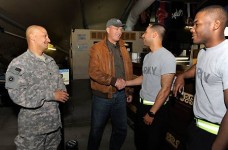 “That ride from Bagram to FOB Mehtarlam was my first in a Black Hawk, and quite a thrill, especially after the pilot offered to show us ‘what it could do.’ You might think that writing a book about helicopters being shot down would not necessarily endear you to chopper pilots everywhere, particularly the MH-60 guys. But happily it has. I was honored to be asked to sign a few Black Hawks on this trip, and hope that my signature works a little voodoo to keep them from ever unexpectedly going down.
“That ride from Bagram to FOB Mehtarlam was my first in a Black Hawk, and quite a thrill, especially after the pilot offered to show us ‘what it could do.’ You might think that writing a book about helicopters being shot down would not necessarily endear you to chopper pilots everywhere, particularly the MH-60 guys. But happily it has. I was honored to be asked to sign a few Black Hawks on this trip, and hope that my signature works a little voodoo to keep them from ever unexpectedly going down.
Looking back, I think that Black Hawk ride was the highlight for me, just a spectacular sensation and sight, swooping over that rugged sunny terrain. I spent a lot of time reconstructing those scenes from my book inside Black Hawks, relying on the memories and descriptions of others, so it felt somehow right to experience a little of it myself. There were other great moments. I still find myself chuckling over Sandra—and what a trooper she was—being literally blown off her feet by the downdraft as they lifted off.”
Kathy also describes some of the flight.
“Flying out to the FOB’s, the terrain was dry and rugged, requiring a flight path though mountain passes. Below, we saw what appeared to be mud-walled hamlets and villages. And a whole lot of open space.”
The word tribal describes the remote regions. We saw many smaller inhabited areas without any roads for access. Looking at the arid landscape, I had to wonder what it would be like conducting a foot patrol down there, especially in the blazing heat of summer.
It’s important to note that approximately 16% of our service members are women and fill 92% of all military jobs. They fly planes and helicopters, drive tanks and MRAP (mine resistant ambush protected) vehicles, go on patrols, and disarm IEDs. They’re engineers, commanding officers, foot soldiers, and aviators. America’s military is well integrated. I asked Sandra what she thought of them.
“I was most impressed by the women service members we met. Having stayed in the same type accommodations in which they live for up to a year, using the same bathroom facilities as they, I have an even greater appreciation of the sacrifices they make! There were no niceties. Yet each seemed committed to the job they’re doing, and they perform it without complaint.”
Army Specialist Justine Shahan, one of our escorts, told me, ‘I decided I hadn’t done anything with my life, and I wanted to.’ One could argue that having reared three sons was doing something! But she wanted to serve. Her sacrifice was inspiring.”
I asked Sandra if in a different life she might’ve served.
“I doubt I would be a good service member, not in this life, or any life!”
It’s an honest answer from the heart, and speaks volumes about the difficult and often stressful life our troops endure, both at home and abroad. Although we tried, none of us could adequately thank them for their service to America. We were constantly reminded of it. In Bagram toward the end of our tour, I remember waking up at 0300 from the earth shaking roar of a jet. I needed to use the latrine. Desperately. Well, I couldn’t just walk a few steps to a convenient bathroom. B-huts don’t have plumbing. I had to get completely dressed and walk 150 yards across uneven, fist sized gravel using a flashlight—in a cold rainstorm. I remember thinking, man, this really sucks.
It was a chilling reminder of what our service members deal with on a daily basis. As Sandra said, there are no niceties. On our third or fourth night, we were awakened at 0200 hours by blaring siren, followed by a loudspeaker announcement that an explosive impact had been detected and to don our IBAs. I flipped on the light, looked at Clive, and asked if he thought we should put on our vests and helmets. His was response was one for the ages. He uttered a single word. “Nah.”
During our stay in Bagram, we had some distinguished company. Lieutenant Colonel Budjenska, the Deputy J-1 for U.S. Forces Afghanistan, was assigned to us as our senior liaison. LTC Budjenska told me privately that when he learned Clive Cussler was coming over on a USO tour, he specifically requested the job. I asked Clive to give us his reaction to having a colonel assigned to us.
“I can never say enough about the courtesy given to us by Colonel Budjenska. Besides being a high level officer he was highly intelligent and I also found him to be a very astute philosopher.
Each of us have really great memories of the trip. On a few occasions when our group went to dinner at a DFAC, I stayed behind and enjoyed a cigar with Clive out in front of our B-hut—right underneath the NO SMOKING sign. Hey, we were behind the sign and couldn’t read it. Besides, LTC Budjenska joined us and gave us temporary “smoking passes.” By the way, I want to thank Clive for sharing the good cigars.
Mark has similar memories.
“I enjoyed our chats with Clive, and was fascinated by my conversation with Mike O’Bryon, the State Department political officer we met on a C-130 flight. There were a few less treasured memories, like the latrines (or lack of them), lugging helmet and body armor, or watching my Eagles get destroyed by the Bears on Monday Night Football at six in the morning—a lousy way for any Philadelphian to start his day!”
That morning, I got up with Mark and we walked over to the Pat Tillman Memorial USO Center to watch the game. We literally watched the Monday Night game on Tuesday morning. It took us several days to adjust to the time change.
I asked Clive the same question, if he had any favorite memories.
“The wild flight in the Black Hawk comes to mind. The food in the mess hall certainly was present in a vast variety. I even began to enjoy our shanty in old shanty town.”
Clive nailed it, the food was really good and there was ample selection and quantity. And I have to admit, returning to our “shanty” after a 19 hour day didn’t seem so bad. Mark, Clive, Jeremy, Mike, LTC Budjenska, and I shared a living space no bigger than a one car garage. Fortunately, we each had lower bunk beds. Unfortunately, the door to our B-hut made a horrible squeaking noise when opened slowly and a awful bang when closed quickly. No amount of oil would’ve fixed it. The door was dragging along the plywood floor. Toward the end, it became a source of cheap amusement. What can we say, we’re men.…
Contrary to what most people might think, the Operation Thriller tours weren’t promotional. We weren’t there to hand out business cards or talk-up ourselves or our books. We were there to thank and acknowledge our service members for their sacrifices on America’s behalf. As chairman of the tour, I often made our introductions purposefully brief. We had very few formal sit-downs in front of large groups. Most of our interaction with troops was face to face in small personal settings. Having said that, we still managed to visit with several thousand service members. We met them in dining facilities, USO centers, command ops centers, The Armed Forces Network radio station, flight lines, boarding terminals, and recreational facilities. If we saw a group of soldiers, we’d walk over and say hello.
Many of the troops were curious about us, but we would always turn the conversations around and ask them about their jobs. Again, we weren’t there to promote ourselves or our books. I did ask Kathy if she encountered a particular question more frequently than others.
“Inevitably I’m asked about the contrast between Temperance Brennan in my books and Temperance Brennan on the television series, Bones. I explain that the show is like a prequel to the novels. It catches Tempe at an earlier point in her life. On screen she’s thirty-something, working at the Jeffersonian in Washington, DC. In print she’s forty-something, working in North Carolina and Quebec, an older, more polished and sophisticated woman.”
I asked Sandra to offer some advice to future Operation Thriller authors.
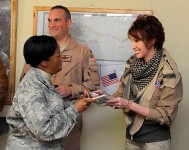 “Pack only what you think you’ll absolutely need. Then cull that till down by half. And ask the USO or ITW to ship your hardcover books ahead of your arrival, so you don’t have to tote them.”
“Pack only what you think you’ll absolutely need. Then cull that till down by half. And ask the USO or ITW to ship your hardcover books ahead of your arrival, so you don’t have to tote them.”
It’s solid advice. We were more fortunate than Operation Thriller I’s authors. They redeployed every single day to a different location, so they had to haul everything with them everywhere they went. We stayed at a central location and returned there every night. Each tour is different, so if you’re selected to attend Operation Thriller III, heed Sandra’s suggestion and pack light.
It’s worth mentioning that there are tens of thousands of civilian contractors working in Afghanistan and Kyrgyzstan. Of the 30,000 people working at Bagram Air Field, one third are civilians. Many of them are Afghans or foreign citizens from the various coalition countries contributing to Operation Enduring Freedom. Civilians are a key component to the effort, especially the Afghan interpreters. Sandra and I were fortunate enough to speak at length with one of them during a lunch break at Grady DFAC.
Our gratitude wasn’t exclusive to the military, we extended it to civilians as well. All of us found it tremendously rewarding to hear about the various jobs and military occupation specialties our troops do on a daily basis. Again, their professionalism is second to none.
This feature doesn’t do justice to the experience we shared. It can’t. I can say with 100% certainty, that Sandra, Mark, Clive, Kathy, and I went on a once-in-a-lifetime event that was both rewarding and enriching. Being able to say thank you—in person—to America’s deployed service members in Kyrgyzstan and Afghanistan will remain valued memories for the rest of our lives.
A huge thank you is also owed to Andy Harp, not only for his service in the Marines, but for making all the ITW/USO Operation Thriller tours possible. His tireless effort and dedication to ITW and the USO is greatly appreciated.
I’d like to close with a question I posed to Clive. I asked him if he could only three words to describe our service members, what would they be?
“Dedicated. Inspirational. Committed.”
*****
 Andrew Peterson’s debut thriller, FIRST TO KILL, has recently been optioned for a major motion picture and is currently available as an ebook. The first in a series, it features Nathan McBride, a trained Marine sniper and CIA operations officer. Andrew’s second book, FORCED TO KILL, launched as an exclusive audiobook from Audible.com and will be available as an ebook later this month.
Andrew Peterson’s debut thriller, FIRST TO KILL, has recently been optioned for a major motion picture and is currently available as an ebook. The first in a series, it features Nathan McBride, a trained Marine sniper and CIA operations officer. Andrew’s second book, FORCED TO KILL, launched as an exclusive audiobook from Audible.com and will be available as an ebook later this month.
To learn more about Andrew, please visit his website.
USO Photos by Mike Theiler
- Africa Scene: Iris Mwanza by Michael Sears - December 16, 2024
- Late Checkout by Alan Orloff (VIDEO) - December 11, 2024
- Jack Stewart with Millie Naylor Hast (VIDEO) - December 11, 2024

